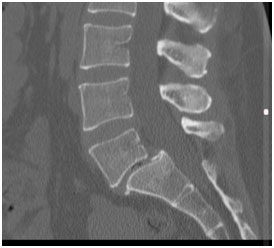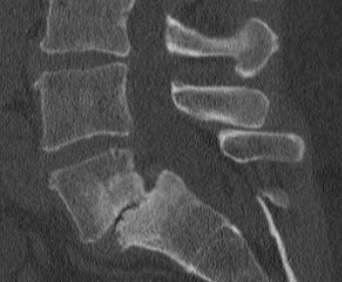Common Conditions
Lumbar spondylolisthesis
Lumbar spondylolisthesis is a condition where one vertebra in the lower spine slips forward over the one beneath it. This misalignment can lead to pain, disc degeneration, stiffness, and sometimes sciatica. Lumbar spondylolisthesis can range from mild to severe, depending on the degree of slippage.
What causes a spondylolisthesis?
Several factors can contribute to lumbar spondylolisthesis, including:
- Degenerative spondylolisthesis: Age-related wear and tear can weaken the discs and joints supporting the spine, creating a degenerative spondylolisthesis. This is the commonest cause and is found in conjunction with lumbar spondylosis, especially at the L4/5 level.
- Isthmic spondylolisthesis: If bilateral pars stress fractures arise at the same level, especially at the L5/S1 level, an isthmic spondylolisthesis may develop. This occurs in young or adolescent athletes, with or without low back pain. A spondylolisthesis is sometimes found incidentally on radiology scans as an adult. It is usually safe to play all sports with a spondylolisthesis. However, there is evidence that it can lead to slightly accelerated disc degeneration and sciatica.
- Developmental spondylolisthesis: Some individuals are either born with or develop biomechanical risk factors which may make them more susceptible to developing a spondylolisthesis.
- Traumatic spondylolisthesis: Severe spinal injury can cause a traumatic spondylolisthesis.
Common symptoms of lumbar spondylolisthesis
Symptoms vary depending on the severity of the slippage and whether nerve compression occurs. Common signs include:
- Lower back pain: Pain is often dull or aching and worsens with activities such as standing, walking, or bending.
- Radiating pain: If nerves are compressed, pain may radiate to the buttocks, thighs, or legs, resembling sciatica.
- Stiffness: Reduced flexibility in the lower back, particularly after rest or prolonged sitting.
- Numbness or tingling: Sensations in the legs or feet, often due to nerve involvement.
- Weakness: In severe cases, leg weakness or difficulty walking may occur.
Diagnosis of lumbar spondylolisthesis
Diagnosis of lumbar spondylolisthesis begins with a clinical assessment that includes a review of your symptoms, medical history, and a physical examination. A doctor will look for signs such as lower back pain, muscle tightness, or neurological symptoms like leg pain, numbness, or weakness. They may assess your posture, gait, and spinal mobility.
Imaging is key to confirming the diagnosis, with the following tests commonly used:
- X-rays (lateral standing view) can clearly show if one vertebra has slipped forward over another.
- MRI scans help assess the condition of spinal discs and detect any nerve compression.
- CT scans may be used for detailed views of bone structures, particularly in pre-surgical planning.
- EOS scans: These is a new modality which takes a standing CT fluoroscopy examination. It is useful in spinal misalignment including spondylolisthesis. However, this examination is costly.
These tests help determine the degree of slippage and whether disc or nerves are affected, guiding decisions about treatment.


Management of lumbar spondylolisthesis
Many cases of minor spondylolisthesis do not require any treatment and do not usually produce symptoms. Treatment for lumbar spondylolisthesis aims to relieve symptoms, stabilize the spine, and prevent further slippage. Options include:
- Conservative management:
Rest and activity modification: Avoiding activities that worsen symptoms, such as heavy lifting or repetitive bending. - Medications:
— Over-the-counter pain relievers like ibuprofen or paracetamol.
— Muscle relaxants or prescription medications for severe discomfort. - Physical therapy:
— Strengthening exercises for the core and back muscles to support the spine.
— Stretching routines may improve flexibility and reduce stiffness. - Injections: Corticosteroid injections may reduce inflammation and provide temporary pain relief, especially if sciatica is present.
- Surgical options: Surgery may be recommended for severe cases, when pain is present or when conservative treatments fail. Procedures may include decompression (removing bone or tissue pressing on nerves) or spinal fusion (stabilizing the spine by fusing the affected vertebrae). There is minimal role for surgery in the absence of symptoms from a spondylolisthesis.

